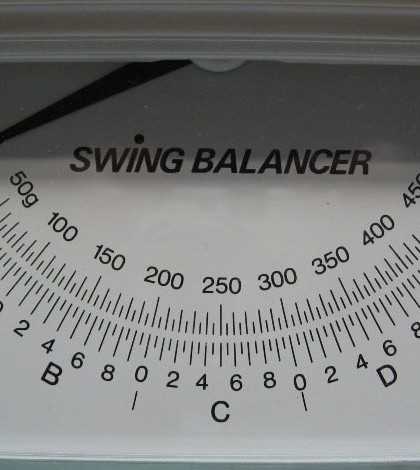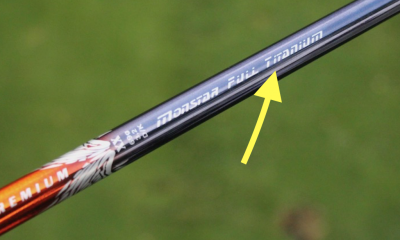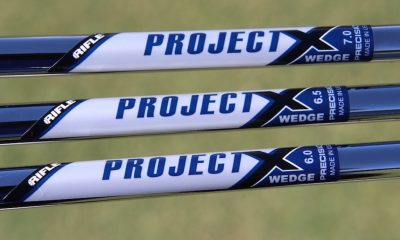Opinion & Analysis
Why You Should Be Playing Heavier Equipment

While I’ve been playing golf for the last 35 years, I only started tinkering with equipment for the last 17 years. I started with regripping and then graduated to full blueprints and rebuilds for myself and close friends and family. This came in handy when I had delusions of trying to compete with the guys in the Long Drivers of America (LDA). While my swingspeed is fast enough to necessitate the replacement of caved heads and broken shafts from time to time, I was humbled back into the amateur ranks very quickly. But the LDA guys were one of the early groups that made me realize that lighter shafts aren’t necessarily better for distance.
When golfers think of a great classic driver, the seasoned ones would talk about persimmon and steel while most WRXers will speak with reverence to the TaylorMade R510TP. This first re-launch of the Tour Preferred series was notorious for the high price tag as well as what justified the cost: the legendary Fujikura Speeder 757 shaft. At one point, you were not considered a player if you didn’t have a Speeder 757 in your driver. At 78 or 79 grams (based on flex), it was much lighter than steel. But its tight profile and low torque made for a very accurate shaft that produced a lower spin rate and allowed for good distance when you wanted to take a healthy swing at the ball.
Today, the manufacturers continue to promise distance gains with a marketer’s perfect formula: lighter total weight and longer shafts. Many WRXers have poo-pooed this concept of longer shafts over the years, professing their love for 44.5 inch drivers. You can go back to the inception of this board to read the questions of how to get a D2 or D3 swingweight on a club that has had the stock length cut down. Today, with some drivers measuring as long as 47 inches, you may have to add 15-20 grams of mass to the head to get the balance back to the club. Some of my early recollections of reshafting include removing the lightweight and big butt shafts from Callaway Great Big Berthas and Goldwin AVDP drivers to install 86 gram EI-70 shafts. My drives were much more accurate with the heavier driver shaft.
Until recently, this trend was applied only to woods and hybrids. But the next phase in the lighter/longer march by the OEMs has been irons. Lofts and lengths have literally made each iron one club longer than a similar numbered iron 25 years ago. And your 120-gram KBS or 130-gram True Temper Dynamic Gold shaft are now being substituted for 85-gram steel or 65-gram graphite. This was the norm for senior and ladies clubs for years. But these lighter weight clubs are now appearing in the men’s market as well.
Thankfully, most of the player or “pro” models still come with heavier shafts. But even there, you still have driver shafts in the 50-gram range, and they seem to be getting lighter each year. This follows the old club thought:
But control always seems to take a back seat to potential distance. I’m sure I could pick up 10-peak yards on a perfectly struck shot with a lighter driver shaft. However, the rest of my imperfect shots would suffer accuracy issues, whereas my heavier shaft would allow me a more consistent face contact and greater AVERAGE distance. My thought when I have built clubs for friends and family was to “swing the heaviest club that did not noticeably cost you distance.” My vindication for this is that your scoring clubs — wedges and putters — are trending heavier or maintaining their shaft weights. Read the GolfWRX thread about increasing accuracy and distance by going back to steel shafted drivers here: http://www.golfwrx.com/forums/topic/705558-now-this-is-how-a-cleveland-classic-should-look
I believe the quickest way to get someone to get excited about the game is to have them strike that one pure shot. Tin Cup described it as a “tuning fork going off in your loins” to Rene Russo, and he was right. Hit that one shot and you will be back for more. My experience has shown that more golfers would have more accurate shots with greater average distance with shaft weights in the following ranges:
Driver: 65-75 grams, 300 gram or more total weight
Fairway Woods: 80-130 grams
Hybrids: 90-130 grams
Irons and wedges: 110-140 grams
Compared to lighter equipment, most of your average male golfers will find the center of the face more often and realize more purely struck shots. This will increase your average distance and minimize the difference between your great shots and your misses.
The one argument that I cannot deny is the lighter weight in your bag if you are a walker. But consider that a golf ball weighs around 45 grams. The difference between heavy and light equipment for someone with three wedges is the equivalent of roughly three sleeves of balls in your bag. If that’s enough to break your back, then you should consider weight/endurance training or move to a push/pull cart. Fatigue at the end of the round from heavier gear is quickly fixed by strength training and sessions at the practice range.
Next time you visit your local clubfitter, pick their brain about being fitted into a slightly heavier shaft in your fairway, hybrid or driver by stressing that you want a more consistent and accurate swing instead of distance. You may find a new favorite club in your bag.
Opinion & Analysis
The 2 primary challenges golf equipment companies face

As the editor-in-chief of this website and an observer of the GolfWRX forums and other online golf equipment discourse for over a decade, I’m pretty well attuned to the grunts and grumbles of a significant portion of the golf equipment purchasing spectrum. And before you accuse me of lording above all in some digital ivory tower, I’d like to offer that I worked at golf courses (public and private) for years prior to picking up my pen, so I’m well-versed in the non-degenerate golf equipment consumers out there. I touched (green)grass (retail)!
Complaints about the ills of and related to the OEMs usually follow some version of: Product cycles are too short for real innovation, tour equipment isn’t the same as retail (which is largely not true, by the way), too much is invested in marketing and not enough in R&D, top staffer X hasn’t even put the new driver in play, so it’s obviously not superior to the previous generation, prices are too high, and on and on.
Without digging into the merits of any of these claims, which I believe are mostly red herrings, I’d like to bring into view of our rangefinder what I believe to be the two primary difficulties golf equipment companies face.
One: As Terry Koehler, back when he was the CEO of Ben Hogan, told me at the time of the Ft Worth irons launch, if you can’t regularly hit the golf ball in a coin-sized area in the middle of the face, there’s not a ton that iron technology can do for you. Now, this is less true now with respect to irons than when he said it, and is less and less true by degrees as the clubs get larger (utilities, fairways, hybrids, drivers), but there remains a great deal of golf equipment truth in that statement. Think about it — which is to say, in TL;DR fashion, get lessons from a qualified instructor who will teach you about the fundamentals of repeatable impact and how the golf swing works, not just offer band-aid fixes. If you can’t repeatably deliver the golf club to the golf ball in something resembling the manner it was designed for, how can you expect to be getting the most out of the club — put another way, the maximum value from your investment?
Similarly, game improvement equipment can only improve your game if you game it. In other words, get fit for the clubs you ought to be playing rather than filling the bag with the ones you wish you could hit or used to be able to hit. Of course, don’t do this if you don’t care about performance and just want to hit a forged blade while playing off an 18 handicap. That’s absolutely fine. There were plenty of members in clubs back in the day playing Hogan Apex or Mizuno MP-32 irons who had no business doing so from a ballstriking standpoint, but they enjoyed their look, feel, and complementary qualities to their Gatsby hats and cashmere sweaters. Do what brings you a measure of joy in this maddening game.
Now, the second issue. This is not a plea for non-conforming equipment; rather, it is a statement of fact. USGA/R&A limits on every facet of golf equipment are detrimental to golf equipment manufacturers. Sure, you know this, but do you think about it as it applies to almost every element of equipment? A 500cc driver would be inherently more forgiving than a 460cc, as one with a COR measurement in excess of 0.83. 50-inch shafts. Box grooves. And on and on.
Would fewer regulations be objectively bad for the game? Would this erode its soul? Fortunately, that’s beside the point of this exercise, which is merely to point out the facts. The fact, in this case, is that equipment restrictions and regulations are the slaughterbench of an abundance of innovation in the golf equipment space. Is this for the best? Well, now I’ve asked the question twice and might as well give a partial response, I guess my answer to that would be, “It depends on what type of golf you’re playing and who you’re playing it with.”
For my part, I don’t mind embarrassing myself with vintage blades and persimmons chasing after the quasi-spiritual elevation of a well-struck shot, but that’s just me. Plenty of folks don’t give a damn if their grooves are conforming. Plenty of folks think the folks in Liberty Corner ought to add a prison to the museum for such offences. And those are just a few of the considerations for the amateur game — which doesn’t get inside the gallery ropes of the pro game…
Different strokes in the game of golf, in my humble opinion.
Anyway, I believe equipment company engineers are genuinely trying to build better equipment year over year. The marketing departments are trying to find ways to make this equipment appeal to the broadest segment of the golf market possible. All of this against (1) the backdrop of — at least for now — firm product cycles. And golfers who, with their ~15 average handicap (men), for the most part, are not striping the golf ball like Tiger in his prime and seem to have less and less time year over year to practice and improve. (2) Regulations that massively restrict what they’re able to do…
That’s the landscape as I see it and the real headwinds for golf equipment companies. No doubt, there’s more I haven’t considered, but I think the previous is a better — and better faith — point of departure when formulating any serious commentary on the golf equipment world than some of the more cynical and conspiratorial takes I hear.
Agree? Disagree? Think I’m worthy of an Adam Hadwin-esque security guard tackle? Let me know in the comments.
@golfoncbs The infamous Adam Hadwin tackle ? #golf #fyp #canada #pgatour #adamhadwin ? Ghibli-style nostalgic waltz – MaSssuguMusic
Podcasts
Fore Love of Golf: Introducing a new club concept

Episode #16 brings us Cliff McKinney. Cliff is the founder of Old Charlie Golf Club, a new club, and concept, to be built in the Florida panhandle. The model is quite interesting and aims to make great, private golf more affordable. We hope you enjoy the show!
Opinion & Analysis
On Scottie Scheffler wondering ‘What’s the point of winning?’

Last week, I came across a reel from BBC Sport on Instagram featuring Scottie Scheffler speaking to the media ahead of The Open at Royal Portrush. In it, he shared that he often wonders what the point is of wanting to win tournaments so badly — especially when he knows, deep down, that it doesn’t lead to a truly fulfilling life.
View this post on Instagram
“Is it great to be able to win tournaments and to accomplish the things I have in the game of golf? Yeah, it brings tears to my eyes just to think about it because I’ve literally worked my entire life to be good at this sport,” Scheffler said. “To have that kind of sense of accomplishment, I think, is a pretty cool feeling. To get to live out your dreams is very special, but at the end of the day, I’m not out here to inspire the next generation of golfers. I’m not out here to inspire someone to be the best player in the world, because what’s the point?”
Ironically — or perhaps perfectly — he went on to win the claret jug.
That question — what’s the point of winning? — cuts straight to the heart of the human journey.
As someone who’s spent over two decades in the trenches of professional golf, and in deep study of the mental, emotional, and spiritual dimensions of the game, I see Scottie’s inner conflict as a sign of soul evolution in motion.
I came to golf late. I wasn’t a junior standout or college All-American. At 27, I left a steady corporate job to see if I could be on the PGA Tour starting as a 14-handicap, average-length hitter. Over the years, my journey has been defined less by trophies and more by the relentless effort to navigate the deeply inequitable and gated system of professional golf — an effort that ultimately turned inward and helped me evolve as both a golfer and a person.
One perspective that helped me make sense of this inner dissonance around competition and our culture’s tendency to overvalue winning is the idea of soul evolution.
The University of Virginia’s Division of Perceptual Studies has done extensive research on reincarnation, and Netflix’s Surviving Death (Episode 6) explores the topic, too. Whether you take it literally or metaphorically, the idea that we’re on a long arc of growth — from beginner to sage elder — offers a profound perspective.
If you accept the premise literally, then terms like “young soul” and “old soul” start to hold meaning. However, even if we set the word “soul” aside, it’s easy to see that different levels of life experience produce different worldviews.
Newer souls — or people in earlier stages of their development — may be curious and kind but still lack discernment or depth. There is a naivety, and they don’t yet question as deeply, tending to see things in black and white, partly because certainty feels safer than confronting the unknown.
As we gain more experience, we begin to experiment. We test limits. We chase extreme external goals — sometimes at the expense of health, relationships, or inner peace — still operating from hunger, ambition, and the fragility of the ego.
It’s a necessary stage, but often a turbulent and unfulfilling one.
David Duval fell off the map after reaching World No. 1. Bubba Watson had his own “Is this it?” moment with his caddie, Ted Scott, after winning the Masters.
In Aaron Rodgers: Enigma, reflecting on his 2011 Super Bowl win, Rodgers said:
“Now I’ve accomplished the only thing that I really, really wanted to do in my life. Now what? I was like, ‘Did I aim at the wrong thing? Did I spend too much time thinking about stuff that ultimately doesn’t give you true happiness?’”
Jim Carrey once said, “I think everybody should get rich and famous and do everything they ever dreamed of so they can see that it’s not the answer.”
Eventually, though, something shifts.
We begin to see in shades of gray. Winning, dominating, accumulating—these pursuits lose their shine. The rewards feel more fleeting. Living in a constant state of fight-or-flight makes us feel alive, yes, but not happy and joyful.
Compassion begins to replace ambition. Love, presence, and gratitude become more fulfilling than status, profits, or trophies. We crave balance over burnout. Collaboration over competition. Meaning over metrics.
Interestingly, if we zoom out, we can apply this same model to nations and cultures. Countries, like people, have a collective “soul stage” made up of the individuals within them.
Take the United States, for example. I’d place it as a mid-level soul: highly competitive and deeply driven, but still learning emotional maturity. Still uncomfortable with nuance. Still believing that more is always better. Despite its global wins, the U.S. currently ranks just 23rd in happiness (as of 2025). You might liken it to a gifted teenager—bold, eager, and ambitious, but angsty and still figuring out how to live well and in balance. As much as a parent wants to protect their child, sometimes the child has to make their own mistakes to truly grow.
So when Scottie Scheffler wonders what the point of winning is, I don’t see someone losing strength.
I see someone evolving.
He’s beginning to look beyond the leaderboard. Beyond metrics of success that carry a lower vibration. And yet, in a poetic twist, Scheffler did go on to win The Open. But that only reinforces the point: even at the pinnacle, the question remains. And if more of us in the golf and sports world — and in U.S. culture at large — started asking similar questions, we might discover that the more meaningful trophy isn’t about accumulating or beating others at all costs.
It’s about awakening and evolving to something more than winning could ever promise.





















Pingback: What Is The Best Golf Shaft Weight? – The Annika Academy
nikkyd
Mar 14, 2014 at 10:54 pm
My irons are sw at e6 and i tell you what, once you get that weight moving, you cannot stop it. Im shorter 5)at 5’8″ and play +1 1/4 ” over standard clubs. I can deadlift 600 lbs and bench 225 25× . Im not flexible by anymeans (not even as a child) but with my handsy swing, i find the heavier, the better. More consistant and straighter than ever . And good distance too! Now if only i could putt on muni greens that stimp out at about -13 haha
Phil
Dec 2, 2013 at 3:48 am
Excellent article. Through experiments I have found that my swing speed has increased by around 3% with a heavier shaft. Also note that swing speed isn’t everything you have to make a quality contact. I have been down the light shaft / totalweight route and am now making a U turn with great results. My latest driver shaft Fujikura Speeder 757 is superb with longer more consistent results Callaway RAZR Tour head with D4 swingweight at 44.75in
It all depends on the type of swing that you have but too many times We get conned with a short term increase in distance but lose control, consistency and accuracy over time.
Dave
Mar 21, 2013 at 7:25 am
Agreed, last year my most consistant club in the bag was my Titleist Hybrid which has a Heavier shaft installed.
Rick
Nov 9, 2015 at 10:48 pm
Exactly the same here…92 gm stiff Diamana ….it is sweet.
Adrian
Dec 11, 2012 at 7:25 pm
Excellent article. Thanks. And I totally agree.
I lost confidence with my rbz 3wood this summer, cut it down a half inch and added some snakeoil to the head. Changed the swing weight from D3 to D6 and it’s now the most consistent long club in my bag, by far. Lost maybe 5 yards of distance on average but added automatic fairways; seems worth it.
Roger F
Nov 30, 2012 at 11:04 am
Great article…..have added weight to my wedges, Putter, gone to heavier shafts on fairways and added tip weights, now have x flex Oxik Altus 86gr in 22 hybrid, very smooth, and 910D3 with Kai’li at 72 grams, regular shaft and 9gr head weight. Lots of Feel,Accuracy!
Ian harris
Nov 30, 2012 at 10:26 am
How about light,stiff,with low torque? Love my steel fiber 95 gram iron shafts. Straight and long!!!
joro3743
Nov 29, 2012 at 8:49 am
I totally agree with the heavier weight. When I was a young man and playing competitively my Driver was steel and wood with a 135 gr. shaft, XX flex, and 43.5 in. and the irons the same.
Today, much older and with several physical problems I use a 45 gr. shaft at 46 and all over the place. Recently I picked up a 60 gr. Stiff Driver with a Ahina shaft and hitting the heck out of it. I know being a club maker for years that the theory of that is wrong, but I love it. I also play a forged Iron with KBS Tour steel and put away the 65 gr. Graphite Irons I was playing.
At 73 this should not work, but it does.
pablo
Nov 28, 2012 at 3:09 pm
I agree. My girlfriend hits better with mens flex shafts even with a very low swing speed. She likes to be able to feel the weight, as it helps her make better ball contact.
John Muir
Nov 28, 2012 at 2:27 pm
I’m finding a lot of success with average male and female golfers and seniors with 45g wood shafts with lighter driver and fw heads and even new 50g iron shafts.
Robert
Nov 28, 2012 at 12:15 pm
Excellent article. Many thanks
Pingback: GolfWRX.com – Why You Should Be Playing Heavier Equipment | Golf Grip Instruction